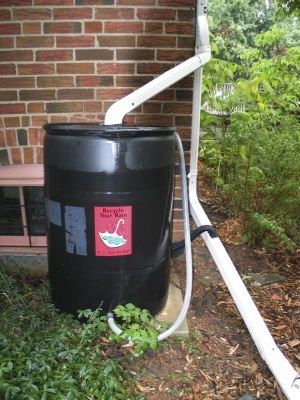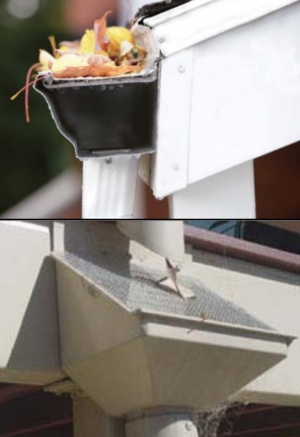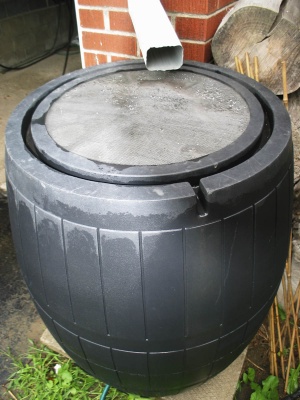Rain barrels
This article is about outdoor, residential systems. For larger, multi-residential or commercial integrated systems, see Rainwater harvesting
Overview[edit]
Rain barrels are an above ground form of rainwater harvesting, typically used in residential settings. The precipitation flows from the roof, to the guttering and down the downspout before being diverted to the rain barrel for storage. You can also view how to set up your own rain barrel system at home by checking out TRCA's How to set up a Rain Barrel and Harvest Rainwater page.
Rain barrels are an ideal technology for:
- Individual homes, where the owners can make good use of the water to irrigate a garden
- Retrofitting single family home neighborhoods
- Areas with mandatory downspout disconnection programs
The fundamental components of a rain barrel system are:
- A catchment where the rain lands, this will usually be a rooftop,
- guttering and downspouts to channel the rainwater,
- screens or filters to remove leaves and other large debris,
- a rain barrel to hold the collected water,
Additional components may include:
- a tap or faucet fitted to the barrel,
- a hosepipe or other irrigation system.
Planning Considerations[edit]
Watershed scale[edit]
Traditional rain barrels require a high degree of owner compliance to perform as a reliable stormwater management control strategy at watershed scale. To overcome this limitation, electronically monitored and controlled rain barrels are a new adaptation on the market in Ontario[1]. This system forecasts rain and automatically discharges the contents of the rain barrel to a designated infiltration area of the property in advance of the storm.
Site Scale[edit]
Place in the Treatment Train In most cases the catchment area will be the roof of the building and the rain barrel will be the first interception of water from the downspout. Planning questions:
- How many downspouts does the roof have?
- Will more than one barrel be required?
- Do the downspouts require reconfiguration?
It is recommended that an overflow strategy be part of designing a rain barrel system. Excess water should be directed away from the property foundations. Suitable discharge points for overflow include: a rain garden, a french drain, or the base of a tree.
Cistern[edit]
Expansion caused by freezing water will damage the barrel. The easiest way to prevent this damage is to drain and disconnect the system in advance of freezing temperatures[2].
For more information on planning considerations and site constraints see Site considerations.
Design[edit]
Filter[edit]
The water in the barrel will remain fresher for use if leaf litter and other debris excluded. Screens can be installed on the eavestroughs, in the downspout, or at the top of the cistern. These types of screens are not designed to capture small particles and chemical pollutants. However, this fine material is usually first to wash off surfaces at the start of the storm. A first flush diverter is a simple, automated, mechanical device which prevents this first 'dirtier' part of the stormwater from being stored. Screens, filters and diverters should be in easily accessible locations, so that they can be inspected and cleared of debris periodically.
Sizing Barrels[edit]
Roof catchment area can be estimated using one of many online digital maps. e.g. Distance can be measured on Google maps by right clicking on the desired start point.
1 mm of rain landing on 1 m2 of roof top produces 1 litre of water to store.
So a 5 mm storm on a 75 m2 roof would require 375 L of storage volume.
Rain barrels are readily available in pre-formed plastic in a variety of sizes, ranging from 150 to 200L (typical) up to 500L.
Alternatives include:
- modular systems to increase total storage capacity,
- slim designs to fit small spaces,
- aesthetic designs for high profile locations,
Many people choose to reuse or recycle a container as a rain barrel or cistern. Re-purposed containers should be screened to prevent mosquitoes from breeding, and should be opaque to prevent algae from growing.
Inspection and Maintenance[edit]
Detailed inspection and maintenance advice can be found in Sustainable Technologies' LID I&M guide. The two primary operational concerns for RWH systems are:
Planning can help ensure that these are identified and fixed more easily and cheaply. Example questions:
- Is the roof (catchment) readily accessible to sweep debris periodically?
- Could the accumulation of debris on the roof be reduced by removing any overhanging branches?
- Can the leaf screens be accessed from the roof? Or, are they installed into the inlet downspout?
- Will the rain barrel require replacement in the future? How will this be assessed?
RWH systems producing higher quality water will have additional maintenance requirements. These will depend on the the treatment technologies being used.
Take a look at the Inspection and Maintenance: Rainwater Harvesting page by clicking below for further details about proper inspection and maintenance practices:
For a table summarizing information on planning considerations and site constraints see Site considerations.
Performance[edit]
Water Quantity[edit]
The effectiveness of rain barrels depends heavily on whether the homeowner will utilize the stored water. The use of rain barrels (190L) across a watershed of 100 residential units has been modelled for a number of U.S. cities[3]. In Philadelphia and Milwaukee (reflecting the most similar climates to Southern Ontario) the use of rain barrels for irrigation only, provided an annual stormwater reduction of less than 2%.
Water Quality[edit]
The Ontario building code (OBC) requires only that water collected from rooftops be "free of solids" for irrigation use in an external system such as a rain barrel. There is a draft of CSA B805 draft currently under review. The scope of the document includes single family dwellings. But the guide is still under review and may not account for rain barrel systems when officially published. (comments made in reference to draft v. 2, on 1st June 2017). Research in warm climates (Texas and Greece) has demonstrated that first flush diverters improve the chemical characteristics of the harvested rainwater[4][5]. However, the use of diverters does not prevent the development of pathogens in stored water. Rain barrels are not typically accepted to provide any quantifiable water quality treatment beyond that achieved through runoff volume and pollutant load reduction.
Life Cycle Costs[edit]
To learn about Life Cycle Costs associated with this practice (i.e. Pre-construction, Excavation, Materials & Installation, Project Management, Overhead, Inspection and Maintenance, Rehabilitation and other associated costs), visit the Rainwater Harvesting & Cisterns: Life Cycle Costs page to view accurate BMP cost estimates and learn to plan your own LID-based project budget with STEP's Low Impact Development Life Cycle Costing Tool (LID LCCT).
Take a look at the Rainwater Harvesting & Cisterns: Life Cycle Costs page by clicking below for further details:
Costs[edit]
Many municipalities run schemes to provide homeowners with subsidized barrels. In some places barrels can be purchased from around $50. See list below.
- Additional items such as filters, screens or hoses may cost extra.
- Hardware stores carry a wider range or products to suit all kinds of space constraints, aesthetic concerns, or budgets.
- Outdoor barrels for the residential market can cost up to $300, these have larger capacity and smart sensors.
Incentives and Credits[edit]
Ontario[edit]
See Also[edit]
External Links[edit]
Organizations[edit]
Proprietary Systems[edit]
In our effort to make this guide as functional as possible, we have decided to include proprietary systems and links to manufacturers websites.
Inclusion of such links does not constitute endorsement by the Sustainable Technologies Evaluation Program.
Lists are ordered alphabetically; link updates are welcomed using the form below.




